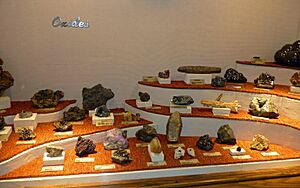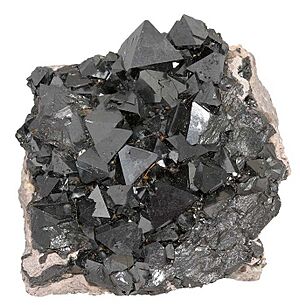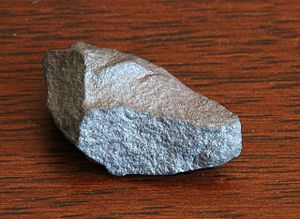Oxide mineral facts for kids

The oxide mineral is a solid substance in which oxygen chemically combines with one or more metals, like iron or aluminum.
These minerals are super important because they are found almost everywhere on Earth. They make up a huge part of the Earth's crust, and many of them are valuable resources that we use every day.
Contents
How Do Oxide Minerals Form?
Oxide minerals can form in several cool ways, often deep inside the Earth or even on its surface.
Forming from Hot Magma
Many oxide minerals are born from incredibly hot, molten rock called magma (when it's underground) or lava (when it erupts from a volcano). As this fiery liquid cools down, different minerals start to crystallize and solidify. Think of it like water freezing into ice, but at much higher temperatures and with different chemical ingredients. For example, the magnetic mineral magnetite often forms this way.
Created by Hydrothermal Activity
Sometimes, hot water that's rich in dissolved chemicals flows through cracks and fissures in rocks. This hot water, called hydrothermal fluid, can react with existing rocks or carry dissolved metals. As the fluid cools or its chemistry changes, oxide minerals can precipitate out of the water and grow into crystals. This process can create beautiful mineral veins.
Made by Weathering and Erosion
Not all oxide minerals form in fiery depths. Many also form on the Earth's surface through processes like weathering and erosion. When rocks are exposed to air and water over long periods, the minerals within them can break down and react with oxygen. For instance, iron-rich rocks can rust, forming iron oxide minerals like hematite, which gives many soils and rocks their reddish-brown color. This is similar to how a bicycle left out in the rain might get rusty!
Common Oxide Minerals You Might Know


There are many different kinds of oxide minerals, each with unique properties and uses. Here are a few famous ones:
Quartz: The Everywhere Mineral
- Chemical Formula: SiO₂ (Silicon Dioxide)
- Hardness: 7 on the Mohs scale (pretty hard!)
- What it is: Quartz is one of the most common minerals on Earth! It's made of silicon and oxygen. You can find it in almost every type of rock, from granite to sandstone.
- Cool Facts: Quartz comes in many colors, like clear (rock crystal), purple (amethyst), pink (rose quartz), and yellow (citrine). It's used in watches, electronics, glass, and even as a gemstone. Its ability to vibrate at a precise frequency when an electric current passes through it makes it perfect for keeping time in clocks and computers.
Hematite: The Red Earth Mineral
- Chemical Formula: Fe₂O₃ (Iron Oxide)
- Hardness: 5.5-6.5
- What it is: Hematite is a major iron ore, meaning it's a rock or mineral from which iron can be extracted. It's made of iron and oxygen. It often has a reddish-brown color, which is why it's sometimes called "bloodstone."
- Cool Facts: Hematite is responsible for the red color of many soils and rocks, including the famous red rocks of Sedona, Arizona, and the surface of Mars! It's also used as a pigment in paints and as a polishing agent.
Magnetite: Nature's Magnet
- Chemical Formula: Fe₃O₄ (Iron Oxide)
- Hardness: 5.5-6.5
- What it is: Magnetite is another important iron oxide mineral, but it has a very special property: it's naturally magnetic! It's one of the few minerals that can act like a magnet.
- Cool Facts: Ancient navigators might have used pieces of magnetite (called "lodestone") as early compasses. Today, it's a major source of iron and is also used in some industrial processes.
Corundum: The Gemstone King
- Chemical Formula: Al₂O₃ (Aluminum Oxide)
- Hardness: 9 (second hardest natural mineral after diamond!)
- What it is: Corundum is an incredibly hard mineral made of aluminum and oxygen.
- Cool Facts: While plain corundum isn't very exciting, its colored varieties are famous gemstones:
- Ruby: Red corundum, colored by tiny amounts of chromium.
- Sapphire: Blue corundum, colored by iron and titanium. Sapphires can actually come in almost any color except red (then it's a ruby!).
- Because of its extreme hardness, corundum is also used as an abrasive in sandpaper and grinding wheels.
Why Are Oxide Minerals Important?
Oxide minerals are not just pretty rocks; they play a huge role in our lives and on our planet.
Sources of Metals
Many important metals, like iron, aluminum, and tin, are extracted from oxide minerals. Without these minerals, we wouldn't have the steel for buildings, aluminum for airplanes, or tin for cans. They are essential for modern technology and infrastructure.
Building Blocks of Rocks
Oxide minerals are fundamental components of many different types of rocks, from igneous rocks that form from cooled magma to sedimentary rocks that form from compacted sediments. They help shape the Earth's geology.
Industrial Uses
Beyond metals, oxide minerals have countless industrial applications. Quartz is vital for electronics and glass. Corundum is used as an abrasive. Titanium dioxide (another oxide mineral) is used as a white pigment in paints, plastics, and even sunscreen!
So, the next time you see a rock, remember that it's likely made up of tiny, fascinating mineral crystals, and many of them are probably oxide minerals, silently doing their important work!



